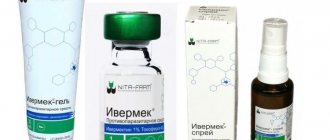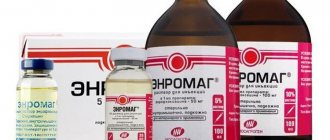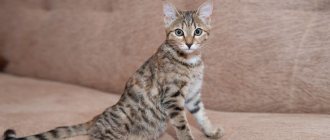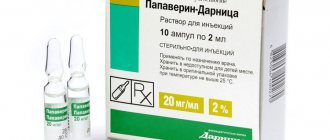Composition and mechanism of operation
The active ingredient of the drug is hydroxymethylquinoxylin dioxide. “Dioxidin” kills harmful microorganisms, promotes a speedy recovery and rapid healing of wounds. Effective against gram-positive, gram-negative, aerobic, including streptococci, staphylococci and other bacteria. They are used as drops in the nose, ears, a solution for washing infected wounds, and also for injections.
The drug is well absorbed and begins to act quickly.
Diagnostics
Establishing an accurate diagnosis is 50% of success when starting therapy for otitis media in cats. The doctor must collect an accurate history (the strength of the manifestations, the presence of discharges, the behavior of the animal, medications taken the day before, as well as new foods in the diet are taken into account).
A clinical examination of the pet is also carried out. The veterinarian examines the ears in detail (in case of severe pain, the cat is given an anesthetic).
For examination, a special instrument is used - an otoscope, which allows one to examine not only the area of the outer ear, but also the deep structures. In case of otitis caused by tumor processes in the ear, during diagnostic measures the animal is administered antihistamines to simplify access to a visual examination in the area of the eardrum.
The cat owner should know that before going to the veterinarian, even if the ears are heavily contaminated with pus and dirt, cleaning is not recommended. The veterinarian must take a sample from the ear canal for cytological analysis and bacterial culture on nutrient media. This is important for making an accurate diagnosis and determining the source of the disease.
If fungal otitis is suspected, a test is carried out to determine the type of fungus that has affected the ear canal. In rare cases, to make a diagnosis of otitis media, a tissue biopsy (if cancer is suspected) and computed tomography (if the inflammatory process affects the deep structures of the ear) are performed.
Instructions for use
For use only in adult animals, prescribed by a veterinarian. In the form of an ointment for cats, this substance is used for wounds of various etiologies. You can lubricate the affected area of skin with it, or put it on a napkin and apply it to the wound. Compresses are made with Dioxidin. For rhinitis and otitis, drop 1 drop into the nose and ears. The number of times a day depends on the severity of the disease. Only the resulting wound can be washed with the solution to disinfect it. For cystitis, flush the bladder with a catheter.
The medicine is administered intravenously in a dosage that is calculated individually based on the age and weight of the cat. The drug must be diluted with 0.9% saline solution. Instructions for use are drawn up by a veterinarian and are followed only under his supervision. For the nose, ears, inhalations and intracavitary use - 1% solution, ointment - 5%, for intravenous administration - 0.5%.
Side effects
After using the drug, side effects such as drowsiness and lethargy may occur.
Occurs rarely, mainly due to hypersensitivity to hydroxymethylquinoxylin dioxide.
When used topically, swelling, redness, rash, and itching are possible. With intravenous and intracavitary administration - headache, lethargy, drowsiness, elevated body temperature, convulsions, loose stools and vomiting. If an allergic reaction occurs, you should always have antihistamines on hand.
Indications
Dioxidine is a fairly popular medicine. It is fully used for the treatment of purulent-inflammatory lesions in farm and domestic animals, and especially often for mastitis. Instructions for use of Dioxidin for cats include its use for: colds, upper respiratory tract infections, otitis media, purulent wounds and mucosal lesions. Dioxidin solution is used to rinse the sinuses, ears and eyes of cats and dogs.
Indications for the use of Dioxidin for cats:
- Rhinitis;
- Otitis;
- Conjunctivitis;
- Mastitis;
- Purulent wounds;
- Abrasions.
A veterinarian can prescribe Dioxidin in the nose of cats with chronic erosive and ulcerative rhinitis, or otitis media caused by anaerobic microorganisms.
© shutterstock
Medicines for animals > Dioxidin 1% (solution)
The information posted on this page is for informational purposes only and cannot be used for self-medication! Before using medications, consultation with a specialist is MANDATORY! Brief description: the effective antibacterial drug Dioxidin 1% exhibits a pronounced bactericidal effect against most gram-positive and gram-negative anaerobic and aerobic pathogens, both spore-forming and non-spore-forming species. The medicine is also active against bacteria that are resistant and have low sensitivity to other antibiotics. When used, the drug has a “gentle” effect on lactic acid microflora. A drug is prescribed for the treatment of latent mastitis, secretion disorders at an early stage, as well as at the beginning of the dry period for sanitizing preventive treatments of the udder. For whom: the medicine is used to treat pathologies of the udder of infectious origin in cows and goats. Release form: the drug is a greenish-yellow, bitter-tasting, transparent liquid, which contains 1,4-di-N-oxide of 2,3-diacetoxymethyl quinoxaline, water for injection and a preservative. The solution is sold packaged in glass ampoules or bottles of 10, 20, 100, 200 cm3. If the drug is stored at temperatures below 15 degrees, crystals may form in it, which are dissolved before use by heating the bottle in a water bath. Dosage: Dioxidin 1% is used as a replacement for antibiotics in standard treatment regimens for mastitis in cattle and goats. Before administering the solution, the affected portion of the udder is thoroughly milked and the teat is disinfected. The drug, having previously been shaken and heated to a temperature of 40 degrees, is administered using a catheter syringe attached to the cannula through the nipple canal. After insertion, the nipple is gently massaged from bottom to top. When treating secretion disorders, 10 ml of solution is administered for 2 days every 8-12 hours; when treating hidden mastitis, 20 ml of solution is administered 2 times a day for 3-4 days. To treat chronic mastitis, 30 ml of solution is injected into the diseased lobe of the udder every 12 hours for 5-8 days. For prophylaxis before the dry period, 30 ml is injected once into each lobe of the udder on the 4th day after its onset. Limitations: if the recommended administration regimens are followed, no side effects are observed. Sometimes allergic reactions may develop. Contraindication is the animal's hypersensitivity to the components of the drug. Milk during the treatment period is allowed to be consumed after the last injection 24 hours later. When inflammatory processes occur in the nose and ears, Dioxidin for cats is used. Often used in veterinary medicine, it has an antibacterial effect. Available in the form of ointment, nasal drops and solution for injection. Every home first aid kit should contain this drug for cats.
This is interesting: Why does a kitten scratch its ears?
Side effects and contraindications
Dioxidin has no contraindications, with the exception of individual allergic intolerance and renal failure.
Side effects include:
- Muscle tremors;
- Increased body temperature;
- Allergic manifestations;
- Digestive disorders;
- Chills.
The antimicrobial antibacterial effect of Dioxidin has a beneficial effect on the healing process and prevents the development of severe purulent infections with timely initiation of treatment. It is important not to self-medicate the animal, but to seek advice from a veterinarian.
Source of the article: https://koshkamurka.ru/dioksidin-dlya-koshek-pokazaniya-i-shema-lecheniya.html
Side effects of Dioxidin
According to the instructions, Dioxidin is an antibacterial agent related to quinoxaline derivatives. The use of Dioxidin has chemotherapeutic activity for various types of infections caused by dysentery, Pseudomonas aeruginosa, Proteus vulgaris, Klebsiella, streptococci, staphylococci, and salmonella.
The use of Dioxidine may contribute to the development of drug resistance in bacteria, therefore dosages must be strictly observed during treatment. Treatment of purulent-necrotic and burn wounds promotes rapid cleansing of surfaces and has a beneficial effect on the healing process.
Dioxidin, when administered intracavitarily, can cause chills, headache, dyspeptic disorders, increased body temperature, allergic reactions, convulsions, and photosensitivity.
When used externally, Dioxidin can cause periwound dermatitis.
Dioxidin treatment of runny nose in cats
Look in the ears to see if they are clean. Today, expert opinions differ regarding the use of Dioxidin for runny nose in children. Treatment of runny nose in cats. The price that is visible in the photo on the packaging is for one ampoule of the drug. Dioxidin drops for cats. Question. Some doctors strictly prohibit the use of the medicine to treat a child, others allow the use of the drug for complications. per day for 5 days, gamavit, nasal drops sanorin, dioxidin pinosol, inhalations. The ulcers are gone. Don't go inside yourself. An ultrasound examination was not ordered. Or maybe chlorhexidine or saline solution is better? They are placed in the ears while slightly warm and allowed to shake out by the cat. They fight a cat's runny nose by rinsing the nose: with a weak solution of dioxidine or furatsilin Runny nose in a child. Special drops and various remedies for rhinitis in cats. You can also dilute Dioxidin with Naphthyzin for children in equal proportions. Dioxidin for runny nose in children reviews. Causes and treatment of runny nose in cats. Acute rhinitis in cats can be cured at home. Children's "Naphthyzin" and dioxidine in a 50/50 ratio.
Accompanied by purulent or watery mucous discharge. Instructions for treating otitis through the nose with dioxidine. Dioxidin for a runny nose. Watery and clear discharge from the animal's nose that is not accompanied by general malaise can be treated at home. Runny nose in cats: causes, methods of treatment and prevention. How to help your tailed friend, and what treatment options for a runny nose in cats are recommended by veterinarians, we will tell you in our article today. How and with what medications to treat a runny nose in a cat, nasal drops. Home Knowledge Base Health Runny nose in cats: treatment at home. Runny nose in a cat. How to take Dioxidin correctly when treating a runny nose? However, like any other medicine, Dioxidin cannot ideally heal wounds in dogs and cats, but sniffing it helped me a lot for a runny nose: the doctor recommended it, who prescribed it to my cat. The condition has not changed, extreme stress has been added: when going to the veterinary clinic, the cat has white or translucent foam coming out of the mouth. Never in a day should you put naphthyzin in the cat’s nose, sanorin, galazolin and other “human” runny nose from drops; all symptoms will go away or three times per day continue If. Principles of dosage of Dioxidin in the treatment of runny nose. , Sniffles, has not eaten for two weeks. Rhinitis in dogs, as in cats, can occur. A runny nose may not stop for months or even years. treatment the nose is clogged, and the cat cannot breathe - naphthyzine 1:1 to dioxidine.
Side effects and contraindications
Dioxidin has no contraindications, with the exception of individual allergic intolerance and renal failure.
Side effects include:
- Muscle tremors;
- Increased body temperature;
- Allergic manifestations;
- Digestive disorders;
- Chills.
The antimicrobial antibacterial effect of Dioxidin has a beneficial effect on the healing process and prevents the development of severe purulent infections with timely initiation of treatment. It is important not to self-medicate the animal, but to seek advice from a veterinarian.
Side effects and contraindications
Dioxidin has no contraindications, with the exception of individual allergic intolerance and renal failure.
Side effects include:
- Muscle tremors;
- Increased body temperature;
- Allergic manifestations;
- Digestive disorders;
- Chills.
The antimicrobial antibacterial effect of Dioxidin has a beneficial effect on the healing process and prevents the development of severe purulent infections with timely initiation of treatment. It is important not to self-medicate the animal, but to seek advice from a veterinarian.
Additional Information
Dioxidin is produced in ampoules in the form of a solution for external and intracavitary use of 1%.
The main active ingredient of the drug is hydroxymethylquinoxylin dioxide. 1 ampoule of Dioxidin contains 100 mg of active substance. According to the instructions, Dioxidin should be prescribed only to adults. Before starting a course of treatment, it is necessary to test for the absence of hypersensitivity by injecting 10 ml of solution into the cavity. If side effects do not develop within 3-6 hours, then you can begin a course of treatment. Chronic renal failure requires a reduction in the dose of Dioxidin.
Dioxidin is a List B prescription drug. The recommended shelf life is two years.










